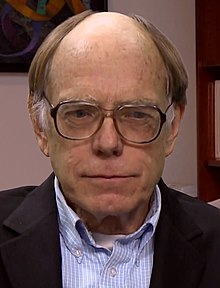| Maynard Olson | |
|---|---|
 Maynard Olson in 2017 Maynard Olson in 2017 | |
| Born | (1943-10-02) October 2, 1943 (age 81) Bethesda, Maryland |
| Education | California Institute of Technology (Caltech), Stanford University (Ph.D. 1970) |
| Known for | Mapping the genome of Pseudomonas aeruginosa |
| Awards | Genetics Society of America Medal, National Academy of Sciences, American Academy of Arts and Sciences, American Philosophical Society, Canada Gairdner International Award, Gruber Prize in Genetics |
| Scientific career | |
| Fields | Chemistry, molecular biology |
| Institutions | Dartmouth College, University of Washington, Washington University in St. Louis |
Maynard Victor Olson is an American chemist and molecular biologist. As a professor of genome sciences and medicine at the University of Washington, he became a specialist in the genetics of cystic fibrosis, and one of the founders of the Human Genome Project. During his years at Washington University in St. Louis, he also led efforts to develop yeast artificial chromosomes that allowed for the study of large portions of the human genome.
Early life and education
Olson was born and raised in Bethesda, Maryland, where he was educated through their public school system. Upon graduating from high school, he received his undergraduate degree from California Institute of Technology (Caltech) and his doctoral degree in inorganic chemistry from Stanford University in 1970. During his time at Caltech, he attended lectures by Richard Feynman which he said was a "memorable experience."
Career
Upon graduating with his PhD, Olson worked at Dartmouth College as an inorganic chemist but experienced "an early mid-life crisis" and chose to change fields. Olsen decided to begin work on genomics in the 1970’s, after reading Molecular Biology of the Gene, by James Watson. He subsequently took a sabbatical and worked with Benjamin Hall at the University of Washington (UW) in Seattle. In 1979, he accepted a position at Washington University in St. Louis, where he began to work on the development of systematic approaches to the analysis of complex genomes. Throughout the 1980s, Olson continued to analyze whole genomes in his own laboratory. He worked with a computer developing algorithms for parallel genome mapping projects through yeast while John Sulston focused on nematode worm, Caenorhabditis elegans. This was one of the first uses of restriction fragment length polymorphisms to map a cloned gene. In 1989, Olson became a member of the Program Advisory Committee on the Human Genome at the National Institutes of Health (NIH).
At the beginning of the following decade, Olson was the recipient of the 1992 Genetics Society of America Medal for his genetic achievements. During the same year, he returned to UW and joined their Department of Molecular Biotechnology. In 1994, Olson was elected to the United States National Academy of Sciences. At the turn of the century, Olson was a lead scientist on a study mapping the genome of Pseudomonas aeruginosa which was published in Nature. The implications of this study led to the possibility of new treatments for patients with cystic fibrosis and patients with severe burns and others who develop this type of infection. As a result of his pioneering gene research, he was the co-recipient of Durham, North Carolina's City of Medicine Award. The citation specifically noted that without his discovery, sequencing the human genome "would not have been possible." In 2003, Olson was elected to the American Academy of Arts and Sciences for "developing technological and experimental innovations critical to genome sequencing." He was elected to the American Philosophical Society in 2005. He was also the recipient of the 2002 Canada Gairdner International Award and 2007 Gruber Prize in Genetics.
Olson retired from his position in 2008.
References
- "Maynard Olson" (PDF). genome.gov. Retrieved March 15, 2021.
- ^ "Green and Olson to receive Gairdner Awards". washington.edu. April 25, 2002. Retrieved March 15, 2021.
- ^ "Genetics Society of America: 1992 Records, Proceedings and Reports" (PDF). genetics.org. 1992. p. 11. Retrieved March 15, 2021.
- "Maynard Olson".
- ^ Thwaites, Tim; Byrne, Niall (2007). "Maynard Olson: a scientist's scientist, and recipient of the 2007 Gruber Prize for Genetics" (PDF). gruber.yale.edu. Retrieved March 15, 2021.
- Allen, William (February 5, 1989). "'Source Book For Biology' Or 'Expensive Tinker Toy'?". St. Louis Post-Dispatch. p. 16. Retrieved March 15, 2021 – via newspapers.com.
- ^ Reedy, Justin (July 19, 2007). "Maynard Olson receives 2007 Gruber Prize for Genetics". washington.edu. Retrieved March 15, 2021.
- ^ "Maynard V. Olson". nasonline.org. Retrieved March 15, 2021.
- Neary, Walter (August 30, 2000). "Scientists sequence the largest bacterial genome yet". washington.edu. Retrieved March 15, 2021.
- "Maynard Olson | Gruber Foundation". gruber.yale.edu. Retrieved 2023-09-09.
- Neary, Walter (October 3, 2000). "Genetic pioneer to receive 'City of Medicine' award". washington.edu. Retrieved March 15, 2021.
- "Six elected to American Academy of Arts & Sciences". depts.washington.edu. May 16, 2003. Retrieved March 15, 2021.
- "APS Member History". search.amphilsoc.org. Retrieved 2021-08-27.
- 1943 births
- Living people
- California Institute of Technology alumni
- Stanford University alumni
- Human Genome Project scientists
- Washington University in St. Louis faculty
- University of Washington faculty
- Members of the United States National Academy of Sciences
- Fellows of the American Academy of Arts and Sciences
- Members of the American Philosophical Society